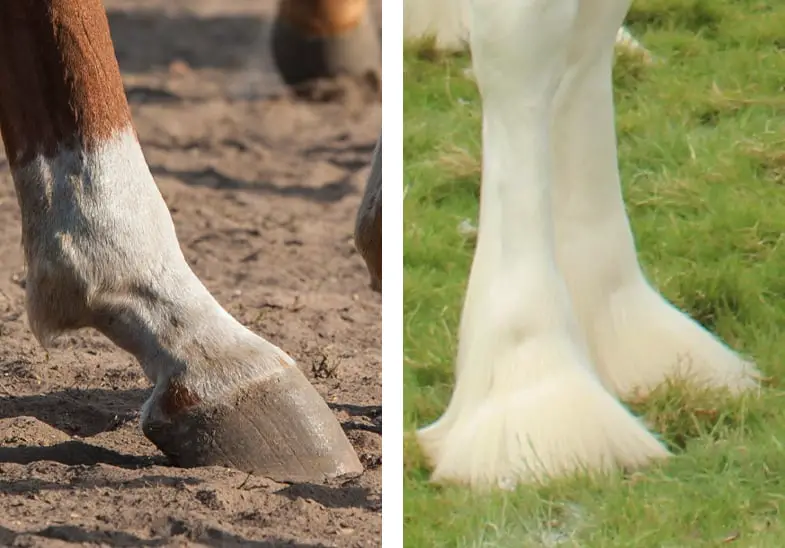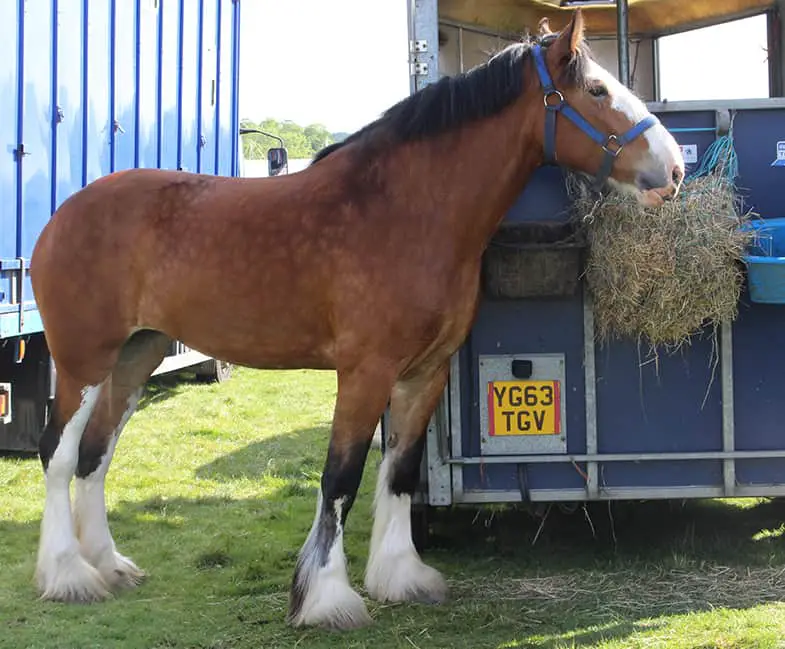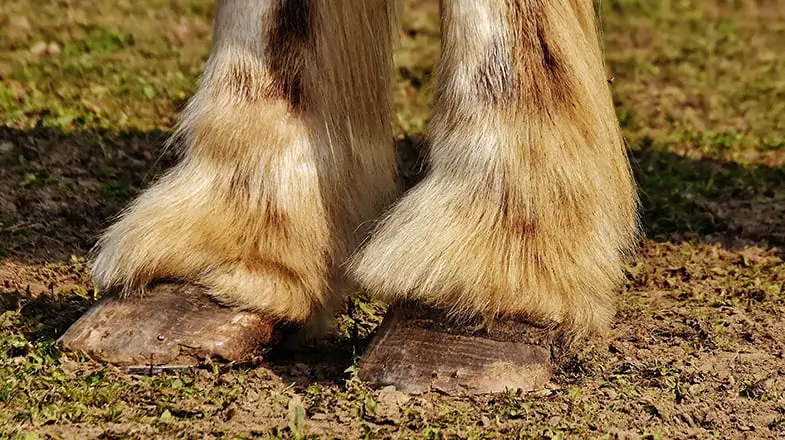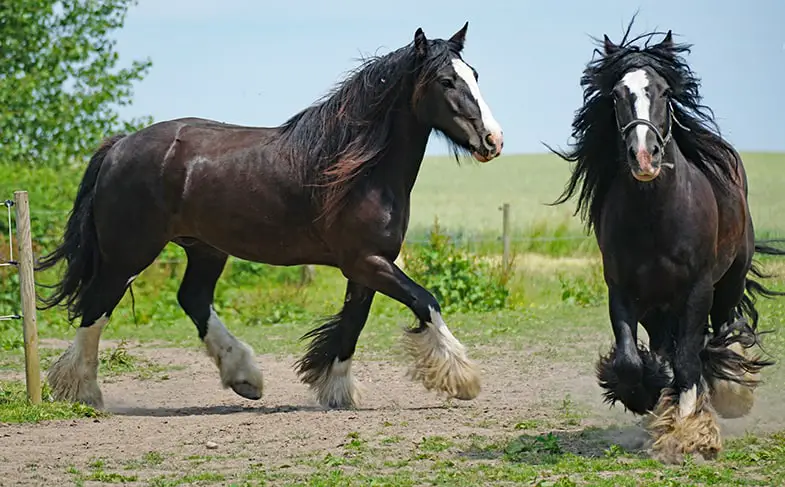While visiting a local show the other day I overheard a young child ask her parents why some of the horses had hairy feet. Her poor parents didn’t know what to say to her and I don’t think I helped when I explained that they were called feathers. The little girl laughed and then asked me why horses had feathers if they couldn’t fly! This started me thinking about why some horses do have feathers and why others don’t.
Why do some horse breeds have hairy hooves? The long hair around a horse’s lower leg is a throwback to a time when they spent their days working on rough terrain, in dense undergrowth, and in muddy fields. It evolved to protect their legs from brambles, sharp rocks, and mud. It also channels water away from the back of their legs and hooves.
Love them or loath them, hairy horse legs are something everybody has their own opinion on but whatever side of the fence you sit on there’s no denying that these long flowing hairs are a real eye-catcher but why don’t all horses have them? Read on to find out more.
Do horses REALLY have hairy feet?
I’ve often heard non-horsey people talking about horses with hairy feet but this technically isn’t the case. Yes the hair on some horses’ legs can be so long it completely covers the hoof (often looking like the hoof is growing the hair itself) but it grows from the leg rather than the hoof itself.
The main ‘ingredient’ of a horse’s hoof is keratin (combined with amino acids) which is the same protein that’s responsible for their coat (as well as their mane and tail) but that’s where their similarities end. While the mane and tail are made up of loose, free-flowing fibers, their hooves (rather like our fingernails) are made from a far harder and more compact cocktail of keratin and amino acids. It’s the compact and compressed nature of the hooves that make it impossible for hair to grow through them.
You might be surprised to know that, despite their course appearance, the long hairs around a horse’s lower leg (which are called feathers) are actually soft and very smooth.
Why do some horses have feathers (and why don’t others)?
When it comes to horse feathers (or feathering as some people call it) there are two main deciding factors, bone density, and native habitat, although in recent years selective breeding has also played a roll.
Before we continue to look at those factors it’s worth pointing out that while most horses will have some hair around their lower leg it’s not the same as feathers. The hair is only referred to as feathers when it completely covers the horse’s lower leg. For example, a Thoroughbred will have a small amount of hair around their fetlock while a Clydesdale will have hair all around their leg.

Bone density
Most horses carry the gene to produce hairy feet (in fact it’s the same gene that controls whether or not a horse has a mustache) but while all horses will have some hair around their lower legs, it’s a horse’s bone density that determines whether or not they actually grow feathers in the first place.
Horses with thinner bones don’t have feathers at all, while draft horse and pony breeds (or those with a lot of draft blood) are far more likely to have hairy legs. I say far more likely because not all draft breeds have feathers.
Native habitat
Horses with feathers have them all year round which is why they’re predominantly found on breeds that are native to colder climates such as some colder areas of the United States, the United Kingdom, France, Germany along with many other European countries.
While it’s not known for sure it’s believed that the long hair evolved as a way of protecting the horse from the cold, wet, and often muddy fields. That said it’s not known why the hair on some horses covers their feet while it doesn’t on others.
Selective breeding
These days most horses are bred for pleasure and show rather than as workhorses but that doesn’t mean feathers have disappeared, in fact, they’re more popular than ever which is where selective breeding comes in. Over time people have specifically bred horses with desirable characteristics which has, understandably, led to said characteristics becoming even more popular and more ingrained within the breed.
What’s the purpose of horse feathers?
When you consider that it’s only draft breeds that have feathers it’s easy to understand that they developed in order to protect the horse’s legs from sharp rocks and thick brambles as they worked the land. As well as this they also helped to keep the lower legs dry and warm in the mud, therefore protecting them from conditions such as pastern dermatitis and hoof thrush.
Of course, these days most riders are careful of where they ride so horses no longer need protection from the undergrowth or from the terrain, that said they can still benefit from protection against the elements which is one reason why they’re still really popular today.
While feathers can help to protect a horse’s lower legs they can also work make conditions such as mud fever worse, especially if the horse’s feathers are wet or if the mud is especially deep.
Do a horse’s feathers need any special care?
While horse feathers are beautiful they do have two main drawbacks, one being that it can make it more difficult to check a horse for injuries and inflammation but the other being that, just like people with long hair, they do require more care.
In order to make sure your horse’s feathers (and legs) are clean, healthy, and in good condition you should detangle (you can use a detangler to help with this) and groom them every day, making sure they’re free from mud, manure, and any other debris. You should also wash them regularly with a mild (or medicated) soap and make sure they’re thoroughly dry. To make sure they’re completely dry to the skin you can use a blow dryer.
Feeding a healthy diet with plenty of omega 3 and 6 oils will help to keep the hairs strong and healthy, while applying oil directly to the feathers will improve their water repelling properties of them.
It’s also worth saying though that if you notice a lot of hair loss or crusty, dry scabs around the feathers you should speak to your vet for advice. Pastern dermatitis is common amongst horses with feathers but it’s also easily treatable.
Is it okay to clip a horse’s feathers?
There’s no reason at all why you can’t trim a horse’s feathers and in some cases, it can even be helpful to the horse. That said though, if you’re intending to show the horse in breed-specific classes (or in some type classes) then you should check beforehand if you’re okay to trim them or not.
If you have no intention of showing the horse then you might want to consider the following when thinking about whether or not to trim their feathers.
Is the weather hot?
If you live in a hot climate, or if your summers are particularly hot then it might be better for the horse to trim their feathers. Doing so will make them more comfortable (and cooler) but it’ll also allow moisture to be quickly wicked away, preventing skin conditions such as pastern dermatitis.
Do you have time to groom them?
Horse feathers need to be groomed every day as well as washed regularly too, if you don’t have time for this then it’s better for the horse’s comfort that you trim them.
What’s the workload like?
If the horse has a heavy workload, or you’re doing a lot of agile sports then it may well be better for the horse to trim the feathers. Doing so will not only help to keep them cool but will also allow you to assess them for injuries.
Veterinary advice
Some vets may advise you to trim the feathers if the horse is prone to skin or lower leg conditions, the reason for this is because they can prevent treatments such as topical gels from getting through to the affected area.
Horse and pony breeds with feathers
Most horses have a small amount of hair around the back of their legs to help the water run off their legs and away from their pasterns and hooves, but it’s draft breeds originating in colder climates that have feathers around the whole of their lower legs.
There are literally dozens of different breeds that have characteristic feathering ranging from well-known breeds such as the much-loved Clydesdale to the not so well known Australian Draft. Then of course there are the pony breeds such as the Fell Pony or the Dales Pony.
While this article would go on forever if I included every single breed with feathers, below are some of the more well-known breeds.
Clydesdale
Height: Anything between 17hh (68 inches) and 18hh (72 inches) is allowed.
Color: Horses typically have white markings and can be found in black, gray, or chestnut, although bay is the most common (and popular) color.
Character: Loved for their calm, docile nature as well as their desire to please, Clydesdales are intelligent horses that are surprisingly versatile.
Country of Origin: Scotland
When you think about horses with thick, hairy feathers around their feet the Clydesdale is probably the first breed that springs to mind which is no surprise, especially when you consider that these iconic horses have adorned many a billboard pulling the famous Budweiser drays.
Originating in Scotland around 300 years ago, the Clydesdale was developed purely as a workhorse and was widely used on farms and in forests throughout Scotland and the whole of the UK. While many farms now use machines to do the work, the Clydesdale is still a popular sight in many plowing and forestry competitions.
Shire Horse
Height: There’s no maximum height for horses although stallions have to be at least 17hh (68 inches) while mares mustn’t be smaller than 16hh (64 inches). Geldings, on the other hand, should be a minimum of 16.2hh (66 inches).
Color: Black, bay, brown, and gray are all allowed, a small amount of white is also permitted.
Character: The Shire Horse has well and truly earned its title of being a gentle giant. Despite their massive size they’re easy to handle and have quiet, gentle natures.
Country of Origin: England
Not much of the Shire Horse’s history is known for sure but it is thought that they may have descended from the horses that William the Conqueror brought over to England in 1066. Sadly though there is no evidence o support this although there’s no reason to think that those horses didn’t influence the Great Horses of the Middle Ages that undoubtedly helped to create the Shire Horse.
Unlike a lot of heavy horses though, the Shire Horse wasn’t originally bred for farming or agriculture but instead, was bred purely as a war horse where its size helped it carry knights, fully covered in armor into battle. In peacetime, their gentle, docile nature meant that they were just as well suited to agricultural work. Over the centuries the Shire Horse has also been used for transporting goods, delivering beer and bread as well as collecting rubbish.
Ardennes
Height: Stallions, on average, stand at around 16hh (64 inches) while mares are typically around 15.2hh (63 inches).
Color: Bay, chestnut, gray, and roan are the most commonly found colors but palomino is also allowed.
Character: Like most heavy draft horses, the Ardennes is a gentle horse that is highly intelligent and extremely people-oriented.
Country of origin: Belgian, France, Luxembourg, and Germany (specifically the Ardennes mountain range)
Being one of the oldest heavy horse breeds in the world today the Ardennes horse is believed to have descended from the heavy horses that were once prized by Julius Caesar and is known to be at least two thousand years old. While originally bred for heavy agricultural work, Arabian blood was introduced in the 18th century to add refinement and agility to the popular breed. Later years have seen Belgian Drafts being used to increase the size and strength of the Ardennes.
The Ardennes gets its name from the Ardennes mountain range (or Ardennes forest as it’s sometimes known), a rough, hilly terrain that has helped the Ardennes evolve into a surefooted, hardworking horse than can cope with the most extreme of weather conditions.
American Cream Draft
Height: Stallions can be as tall as 16.3hh (67 inches) although most horses stand between 15hh (60 inches) and 16hh (64 inches).
Color: All horses have a white mane and tail with a cream-colored coat that can range from a pale cream to a golden cream, with pink skin. Foals are often born with white eyes that change to amber by the time they reach maturity.
Character: Known for their calm, gentle temperament and willingness to learn, American Cream Drafts are easy to handle and have docile natures.
Country of Origin: USA
As you can probably tell by its name the American Cream Draft is a native of the United States, but what you probably didn’t know though was that the breed is one of the newest draft horse breeds in the world today. All horses today are descended from just one horse, a mare known as Old Granny, who was purchased at a horse sale in 1911 by Harry Lakin, an Iowan livestock dealer. Originally known as the American Cream it wasn’t until 1991 when the Draft part was added to their name after blood testing found that there was nothing but draft blood in their history.
Like so many draft breeds, the American Cream Draft’s numbers started to drop as soon as the tractor came along but sadly, unlike other breeds they haven’t recovered. Today the breed is considered extremely rare and in real danger of extinction with less than 100 breeding mares worldwide. With less than 75 foals being born every year there’s little chance of this changing any time soon.
Gypsy Vanner
Height: Typically horses stand at 14.2hh (58 inches) but they can range from 12.2hh (50 inches) to 16hh (64 inches).
Color: Mainly piebald or skewbald but any solid color is also allowed.
Character: Gypsy Vanners are gentle horses that are patient and unflappable. They also have calm natures and can easily be handled by children and beginners alike.
Country of Origin: Ireland
Some people argue that the Gypsy Vanner isn’t a true breed and is nothing more than a colored horse with no definable standard, but this couldn’t be further from the truth. Yes, they are known for their eye-catching coat patterns but they’ve never been specifically bred for this. The color is only there because at the time the breed was developed colored horses weren’t in fashion so were much cheaper to buy. Historically they were bred for their strength, and toughness as well as for their gentle natures.
While the breed can trace its roots back to the early 19th century it wasn’t until the formation of the Traditional Gypsy Cob Association (in 1996) that the Gypsy Vanner was officially recognized as a breed in its own right.
Fell Pony
Height: Most ponies stand at around 13.2hh (54 inches) although they can reach 14hh (56 inches).
Color: Only solid colors are allowed with black, brown, bay, gray, and chestnut being the most common. A small amount of white is allowed on the lower hind legs as is a star on the pony’s head.
Character: Fell ponies are extremely intelligent ponies that are known to have a friendly, if somewhat mischievous nature. They also have a very strong survival instinct.
Country of origin: England
Don’t let the size of these beautiful little ponies fool you, they’re stronger and tougher than you might realize and have been used for light draft work for hundreds (if not thousands) of years. In fact, during the Roman occupation of Great Britain (which lasted from 43 to 410AD) they were used to haul heavy building materials around Northern England. Their draft background has meant that they’re also a popular choice for use in carriage races and were a favorite of the late Prince Philip.
Like practically every other draft breed on the planet, the introduction of mechanized farming meant the Fell Pony saw a drastic decline in numbers with only 5 stallions left at one point. Thankfully though, thanks to the help of people like King George V, Beatrix Potter, and many others the Fell Pony has seen a revival in popularity and is no longer considered a rare breed.
Dales Pony
Height: The average height for Dales Ponies is between 14hh (56 inches) and 14.2hh (58 inches).
Color: Black is by far the most common color although brown, bay, gray, and roan can also be found. Like the Fell Pony, a small amount of white is also permitted.
Character: The Dales Pony is a very sensible little pony that is surefooted and calm under pressure. They also have a great deal of stamina and agility.
Country of origin: England
A close relative of the Fell Pony, the Dales Pony has been bred in the Yorkshire Dales region of Great Britain for hundreds of years although it wasn’t until the end of the 19th century that it was officially recognized as a breed in its own right. Like their close cousin, the Dales Pony was purposefully bred for draft and pack work and has a phenomenal amount of strength and stamina in relation to their size. It wasn’t unheard of for them to cover over 200 miles (322 km) in a single week.
Due to their native moorland habitat, the Dales Pony has developed to be an extremely tough pony that can quite happily live outside without a blanket, regardless of the temperature (yes that does include snow!). They’re also very surefooted and have calm natures which makes them a great trail horse, especially over the toughest and most rugged of terrain.
Welsh Cob (Section D)
Height: All horses must be at least 13.2hh (54 inches) tall but the average is 15hh (60 inches).
Color: Any solid color is allowed although chestnut, bay, gray, and black are by far the most common.
Character: The Welsh Cob is known for its courage as well as for its gentle nature. They are also very hardy and strong horses.
Country of origin: Wales
Part of a group of breeds known as mountain and moorland breeds, the Welsh Cob (or Welsh Section D) is known to have been in existence since the Middle Ages when British knights valued them as strong and sensible mounts. It’s also believed that the Crusaders (who brought Oriental horses back with them when they returned from the Middle East) introduced Arabian blood into the Welsh Cob. An act that only helped to improve upon the breed’s speed, strength, and agility.
Like a lot of British mountain and moorland breeds, the Welsh Cob is a hardy animal that is happier spending winter outside, often getting stressed if they’re stalled for any length of time.
I hope you found this article helpful. If you did I’d be grateful if you could share it please as it would really help me.
Recommended products
Over the years I have tried hundreds of different horsey products, from various blankets and halters to different treats. Some I’ve loved, others I’ve hated but I thought I’d share with you my top all-time favorite products, the ones I never leave the yard without. I’ve included links to the products (which are in no particular order) that I really think are great.
- Horse Knots by Reference Ready – If you’re like me and enjoy pocket reference guides then you’ll love this knot tying guide. These handy cards can easily fit in your pocket or attach to the saddle for quick reference. They’re waterproof, durable and are color coded to make them easy to follow.
- Mane ’n Tail Detangler – Even if you never show your horse you’ll need to detangle his tail from time to time (and possibly his mane too) which is always a challenging chore! I’ve found that if I run a little bit of detangler through my horse’s tails every few days it stops them from getting matted up and makes combing them easy, even if they’re coated in mud. I don’t know if I should admit to this or not but it also works wonders on my hair.
- TAKEKIT Pro clippers – Over the years I’ve tried a lot of different clippers and while some were obviously better than others I found these to be by far the best. They are heavier than a lot of other clippers but for me, that’s a good thing, it makes them feel more sturdy and hardwearing. On top of that they have a range of speeds so are just as good for clipping your horse’s back as they are his face. I also like the fact that they come in a handy carry case but that’s not for everybody. The company that makes them is super good and incredibly helpful too, a real bonus these days. The only thing I wasn’t keen on was the fact that it doesn’t come with any oil, but that’s not a major problem as it’s not difficult to buy lubricant.
- Shire’s ball feeder – There are so many boredom buster toys out there but I like to use these every day, regardless of whether or not my horses are bored. I find that it helps to encourage my horses to problem solve by rewarding them with treats (or pieces of fruit) but it also mimics their natural grazing behavior which helps to keep them calm and de-stressed.
- Horse safe mirror – This is a strange one that many people are surprised about but I like to put horse safe mirrors in the trailers as well as in the quarantine stalls. It helps to prevent the feeling of isolation by giving the impression of other horses being around. Being herd animals horses can get extremely stressed when they feel that they’re on their own but with these stick-on mirrors, they believe that at least one other horse is with them.
- Rectal thermometer – I know this isn’t glamourous at all but it’s vital for your horse’s well-being to be able to check their temperature and a rectal thermometer is the easiest way of doing this which is why I’ve added it to the list.
Shopping lists
I’ve also put together a few shopping lists of essential items that I’ve found helpful over the years. I’ve broken the lists down into different categories rather than put everything in one massive list 😉



